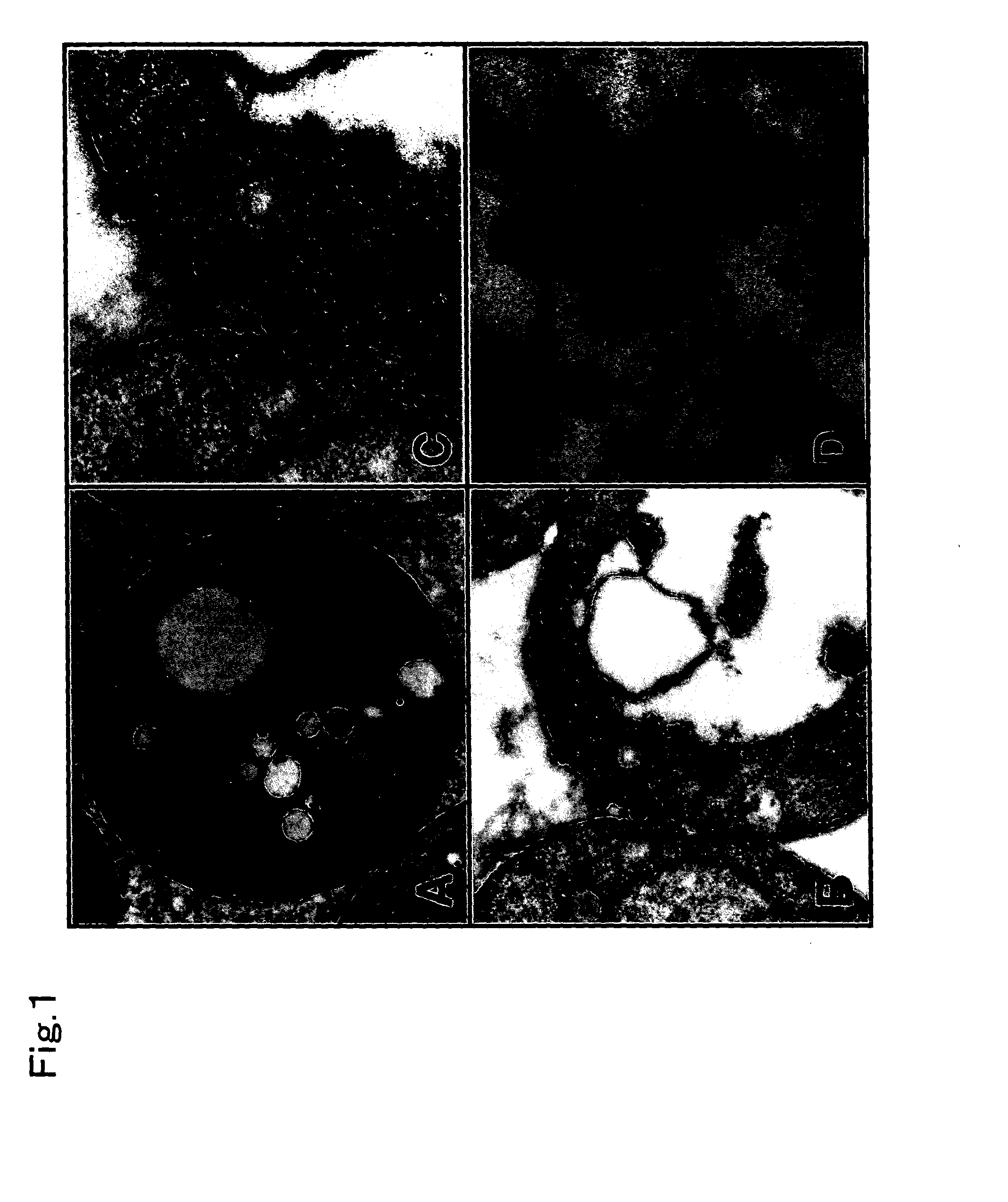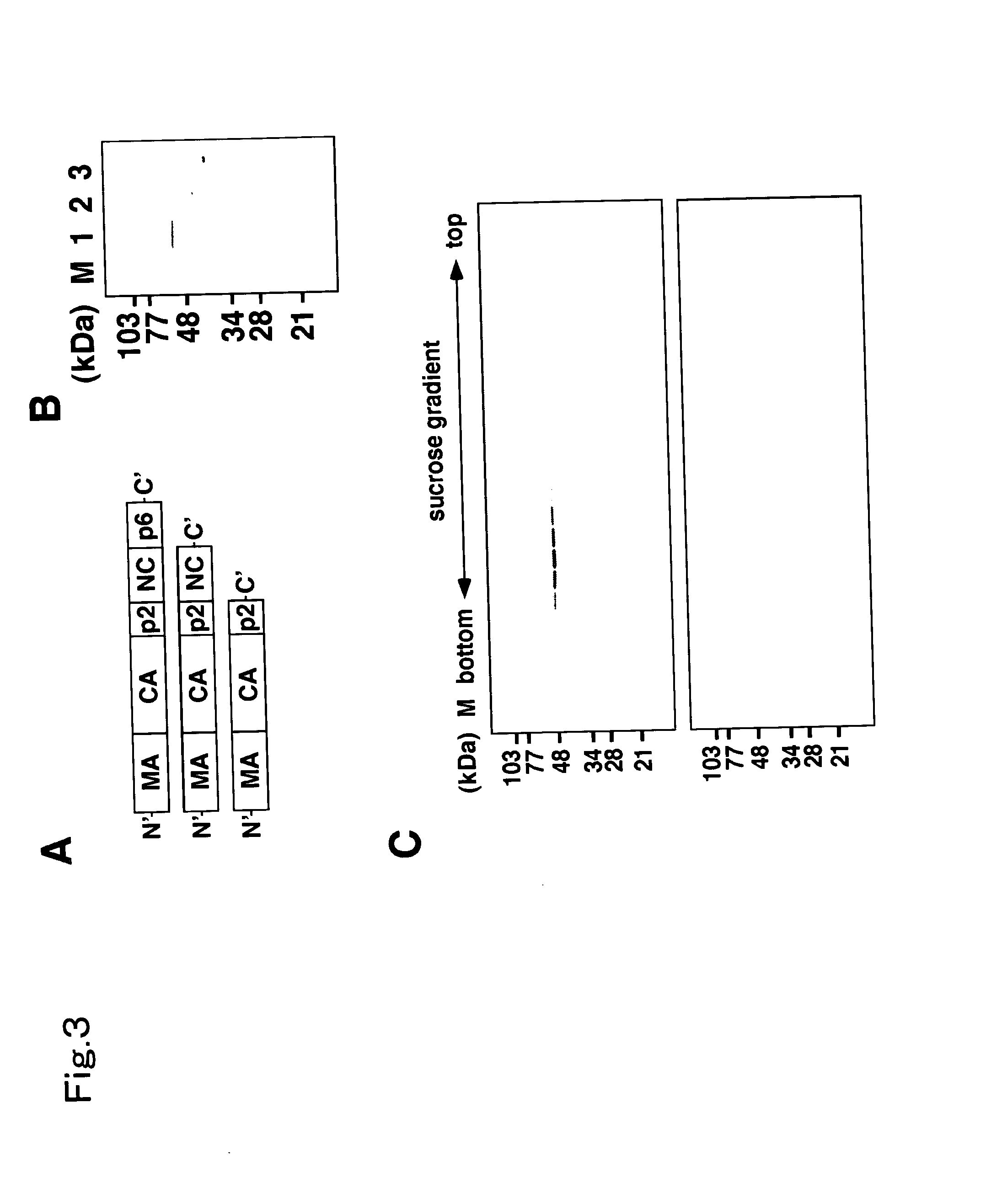Virus-like micrograins and process for producing the same
a technology of virus-like microorganisms and virus-like grains, which is applied in the direction of recombinant dna-technology, antibody medical ingredients, peptide sources, etc., can solve the problems of limited use of licensed cell lines, low yield of particles produced, and restricted use of them from the viewpoint of safety
- Summary
- Abstract
- Description
- Claims
- Application Information
AI Technical Summary
Problems solved by technology
Method used
Image
Examples
example 1
Budding and Releasing of HIV VLP from Yeast Spheroplast Cell
[0103] A cDNA fragment encoding HIV Gag protein (fill-length, MA-CA-p2-NC or MA-CA-p2) was inserted into YEp type vector pKT10 having URA3 for a selection marker and GAP promoter for constitutive expression (Tanaka, K. et al., 1990, Mol. Cell. Biol. 10: 4303-13) to construct a Gag protein-expression vector. The vector was introduced into RAY3A-D strain (MATa / a ura3 / ura3 his3 / his3 leu2 / leu2 trp1 / trp1) (Ruggieri, R. et al., 1989, Proc. Natl. Acad. Sci. USA 86: 8778-8782) of yeast (Saccharomyces cerevisiae) by electroporation. The yeast cells were grown on a uracil selective plate (0.67% yeast nitrogen base, 2% glucose, uracil-free amino acid mixture, 2% agar), and the formed colonies were selected as transformed cells. A lysate of this transformed yeast cells were analyzed by SDS-PAGE and Western blotting (Towbin, H. et al., 1979, Proc. Natl. Acad. Sci. USA 76: 4350-4354) using anti HIV-1 CA monoclonal antibody (Advanced Biot...
example 2
Confirmation of the Presence of Lipid Bilayer Membrane
[0107] It is known that the Gag protein in VLP which is completely enveloped by a lipid bilayer membrane is not digested by protease unless the lipid bilayer membrane is removed with a surfactant or organic solvent (Konvalinka, J. et al., 1995, Eur. J. Biochem. 228: 191-198; Spearman, P., and Ratner, L. 1996, J. Virol. 70: 8187-8194). In order to confirm that the VLP obtained by the present invention had the lipid bilayer membrane as an outer membrane, the VLP was subjected to 1% Triton X-100 treatment and trypsin digestion.
[0108] Triton X-100 was added to the purified VLP fraction to a final concentration of 1% in order to solubilize the lipid bilayer membrane. In the presence or absence of Triton X-100, trypsin was added to the VLP fraction at 1 mg / ml, and the Gag protein was digested at 30.degree. C. for 30 minutes.
[0109] The sample was analyzed by SDS-PAGE, followed by Western blotting. The anti-HIV-CA monoclonal antibody (Ad...
example 3
VLP Production Competence of Truncation Mutant of Gag
[0111] In the Gag protein expression in higher eukaryotic cells, it is known that, although the VLP production is not affected by the deletion of the p6-C terminus from the domain structure of the Gag protein (polyprotein of N terminus-MA-CA-p2-NC-p6-C terminus), VLP is not formed if the NC-p6-C terminus is deleted (Gheysen, D. et al., 1989, Cell 59: 103-112; Wang, C. T. et al., 1998, J. Virol. 72: 7950-7959). Whether these Gag mutants show similar assembly phenotypes when expressed in yeast was examined by expression of a wild type Gag protein (MA-CA-p2-NC-p6) and the truncation forms (MA-CA-p2-NC and MA-CA-p2) (FIG. 3A). The truncation forms were constructed by PCR. The VLP in the culture supernatant was subjected to equilibrium centrifugation in a 20-70% (w / v) sucrose gradient and detected by Western blotting using the relevant gradient fraction, which was fractioned from the bottom to the top.
[0112] The result showed that, alt...
PUM
| Property | Measurement | Unit |
|---|---|---|
| Immunogenicity | aaaaa | aaaaa |
Abstract
Description
Claims
Application Information
 Login to View More
Login to View More - R&D
- Intellectual Property
- Life Sciences
- Materials
- Tech Scout
- Unparalleled Data Quality
- Higher Quality Content
- 60% Fewer Hallucinations
Browse by: Latest US Patents, China's latest patents, Technical Efficacy Thesaurus, Application Domain, Technology Topic, Popular Technical Reports.
© 2025 PatSnap. All rights reserved.Legal|Privacy policy|Modern Slavery Act Transparency Statement|Sitemap|About US| Contact US: help@patsnap.com



